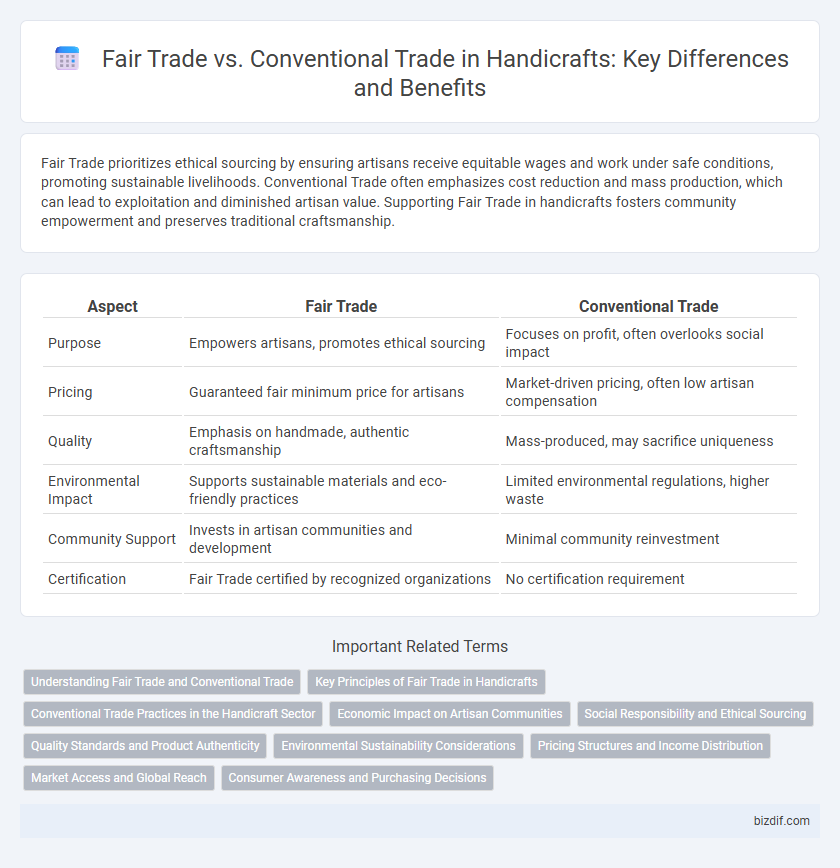Fair Trade prioritizes ethical sourcing by ensuring artisans receive equitable wages and work under safe conditions, promoting sustainable livelihoods. Conventional Trade often emphasizes cost reduction and mass production, which can lead to exploitation and diminished artisan value. Supporting Fair Trade in handicrafts fosters community empowerment and preserves traditional craftsmanship.
Table of Comparison
| Aspect | Fair Trade | Conventional Trade |
|---|---|---|
| Purpose | Empowers artisans, promotes ethical sourcing | Focuses on profit, often overlooks social impact |
| Pricing | Guaranteed fair minimum price for artisans | Market-driven pricing, often low artisan compensation |
| Quality | Emphasis on handmade, authentic craftsmanship | Mass-produced, may sacrifice uniqueness |
| Environmental Impact | Supports sustainable materials and eco-friendly practices | Limited environmental regulations, higher waste |
| Community Support | Invests in artisan communities and development | Minimal community reinvestment |
| Certification | Fair Trade certified by recognized organizations | No certification requirement |
Understanding Fair Trade and Conventional Trade
Fair Trade emphasizes equitable trading conditions, ensuring artisans receive fair wages and sustainable livelihoods, whereas Conventional Trade often prioritizes profit margins with less focus on ethical labor practices. Fair Trade certification guarantees transparency, social accountability, and community development, contrasting with Conventional Trade's market-driven pricing and supply chain models. Understanding these differences highlights the impact on artisan communities and consumer choices in the handicraft sector.
Key Principles of Fair Trade in Handicrafts
Fair Trade in handicrafts emphasizes fair wages, safe working conditions, and environmental sustainability, ensuring artisans receive equitable compensation and respect for their labor. It promotes transparency, community development, and the preservation of traditional techniques, contrasting with conventional trade which often prioritizes cost reduction and mass production. These principles empower marginalized artisans, fostering economic independence and cultural heritage conservation through ethical market practices.
Conventional Trade Practices in the Handicraft Sector
Conventional trade practices in the handicraft sector often prioritize mass production and cost efficiency, leading to the exploitation of artisans through low wages and poor working conditions. These practices disregard sustainable sourcing and fair labor standards, resulting in limited economic benefits for local communities and compromised craftsmanship quality. Limited transparency in supply chains further allows unethical practices to persist, undermining the social and environmental integrity of handicraft products.
Economic Impact on Artisan Communities
Fair Trade practices ensure artisans receive equitable wages, fostering sustainable income growth and improving local economies more effectively than Conventional Trade, which often exploits low labor costs. Fair Trade also promotes reinvestment in community development, education, and healthcare, directly uplifting artisan communities. Conventional Trade frequently prioritizes profit over social welfare, resulting in economic disparities and limited long-term benefits for artisans.
Social Responsibility and Ethical Sourcing
Fair Trade in handicraft emphasizes social responsibility by ensuring artisans receive fair wages, safe working conditions, and community development support, contrasting sharply with Conventional Trade's frequent neglect of these ethical standards. Ethical sourcing under Fair Trade guarantees transparency and respects cultural heritage, promoting sustainability and equitable partnerships. Conventional Trade often prioritizes cost reduction over social impact, leading to exploitation and compromised labor rights in the handicraft sector.
Quality Standards and Product Authenticity
Fair Trade handicrafts adhere to rigorous quality standards that emphasize handmade techniques, sustainable materials, and ethical production processes, ensuring authentic cultural representation and superior craftsmanship. Conventional trade products often prioritize mass production and cost-efficiency, which can compromise product authenticity and quality consistency. Certified Fair Trade labels provide consumers with verified assurance of genuine craftsmanship and adherence to socially responsible practices.
Environmental Sustainability Considerations
Fair Trade promotes environmental sustainability in handicrafts by enforcing stricter standards on resource use, waste management, and chemical-free materials, reducing ecological footprints compared to Conventional Trade. Conventional Trade often prioritizes mass production and cost reduction, potentially leading to unsustainable resource exploitation and environmental degradation. Fair Trade's focus on renewable materials and eco-friendly practices supports biodiversity conservation and long-term ecological balance in the handicraft sector.
Pricing Structures and Income Distribution
Fair Trade pricing structures ensure that artisans receive a guaranteed minimum price that covers living wages and sustainable production costs, while conventional trade often subjects producers to volatile market prices, leading to income instability. Income distribution in Fair Trade models emphasizes equitable profit-sharing with direct payment to the craftsmen, promoting community development and economic empowerment. In contrast, conventional trade commonly involves multiple intermediaries, which reduces the share of income reaching the actual artisans and limits their financial growth.
Market Access and Global Reach
Fair Trade in handicrafts ensures artisans gain direct market access by connecting them with ethical buyers and niche consumer bases that prioritize sustainability and social impact, expanding their global reach beyond local or regional markets. Conventional trade often relies on intermediaries, restricting artisans' visibility and limiting market access to traditional distribution channels with less emphasis on ethical practices. This contrast in market access and approach to global reach affects price fairness, artisan empowerment, and the overall sustainability of the handicraft sector.
Consumer Awareness and Purchasing Decisions
Consumer awareness significantly influences purchasing decisions in the handicraft sector, with fair trade products often favored for their ethical sourcing and support of artisan communities. Studies show that buyers are increasingly prioritizing transparency, sustainability, and social impact over conventional trade's lower prices. Enhanced knowledge about fair trade practices directly correlates with a willingness to pay premium prices, driving market demand for ethically produced handicrafts.
Fair Trade vs Conventional Trade Infographic

 bizdif.com
bizdif.com